His name was Hap Davis, gardener, woodsman, hunter, fisherman, teller of tall tales. I heard a neighbor of his say one day that the only way to ever catch a fish bigger than Hap was to tell your story last. He had a huge, half-way-to-the-knees, low-slung dewlap belly, a cancerous bump in the corner of his nose, rolled his own cigarettes, and was almost always lying down taking a nap. Hap was also the father of my first serious girlfriend, Edie May.
That notwithstanding Hap and I did a lot of fishing and clamming together. We would troll for sea bass among the islands of Casco Bay in a small motorized canoe, and he couldn’t swim. Many times when the tide was out during daylight we’d be clamming, backbreaking work that produces a multitude of tiny cuts on your hand from shell fragments. When the tide was right, we’d see mussels but leave them alone. Inland we’d fish the rivers, the Royal a common one. There Hap would shuck freshwater mussels to use for bait and look for black pearls. Edie May and her mother, Florence (Brown) had quite a collection of them.
Hap was the first person I ever saw eat a clam raw. Actually it was a quahog, a really big clam. But he never sampled or harvested the salt water mussels nor did he eat the freshwater mussels. Now days salt water mussels are gourmet fare. I used to walk over thousands of them in mounds when the tide was low. Freshwater mussels are edible, too, but preparation and cooking is required. Locally there are several species one can harvest for dinner. There are some 300 native species in North America, seven west of the Continental Divide, none in Hawaii though the later has one invasive species, the Asian Clam, which is a mussel. Some 200 North American species are endangered or extinct, many of those surviving are protected. Identify your local freshwater mussels and follow appropriate regulations. Make sure your identification is correct. Fresh water mussels are one of the most threatened groups of animals in North America. The given reason for the decline in their population is sedimentation caused by land use which means look for them in clean water not silty or polluted water. They can live to 200 years old, more than enough time for these filter feeders to collect some nasty chemicals in them.Regardless of where you harvest freshwater mussels they must be thoroughly cooked to kill of serious parasites. Handle them like contaminated chicken. Gather them only from pristine waters. Younger is better than older.
If you go collecting mussels in Florida remember the tune Suwannee River. North and west of that river are seven federally protected species; Gulf Moccasinshell, Ochlockonee Moccasinshell, Chipola Slabshell, Shinyrayed Pocketbook, Fat Threeridge, Oval Pigtoe, and Purple Bankclimber. Don’t harvest them. The fines are substatial. Two mussels that were harvested in Florida up to a couple of years ago, the Choctaw Bean and the Tapered Pigtoe, are up for consideration this year to be protected.
South of the Suwannee six freshwater mussels are regulated in varying degrees. They are, when the article was written: The Florida Shiny Spike (Elliptio buckleyi) which must be 3-inches long. Bag limit is 20-half shells per day. The Paper Pondshell (Utterbackia imbecillis) must be 3.5 inches long, bag limit 20-half shells a day. (Isn’t that a great name, Utterbackia imbeciles? It’s also fairly common in North America.)
There are no bag or possession limits for unprotected species which includes the forementioned Asian Clam (Corbicula fluminea) which must be 1.5 inches across. Three other species have no harvesting restrictions beyond size: The Atlantic Rangia (Rangia cuneata) 3 inches, the Carolina Marschclam (Polymesoda caroliniana) , 3.5 inches, and the Fingernail Clam (Pea Clam) (Musculium, Sphaerium or Pisidium) half-inch.
How do you collect freshwater mussels? Locally by hand. Specialized tools are not allowed. You will find them in shallow, sandy lake, river and stream bottoms, and shorelines usually half buried, head and foot end down. A bucket with a clear bottom or snorkeling is a common method of location. Never select mussels that are chipped, broken, or damaged in any way. Also never take one that is open. It’s probably dead already. If you plan on collecting some regulated freshwater mussels the easiest thing to do to make sure they are the right size is to go to a hardware store and buy a metal ring that has the inside diameter of the mussel you want to collect. As an example, for the Asian “Clam” the ring should be 1.5 inches across on the inside. If the mussel drops through, it’s too small. If it wedges or won’t go through, it’s legal. Or you can make one by drilling a 1.5 inch hole in a small piece of wood or cutting off a small ring of PVC pipe with a 1.5 inch inside diameter.
The Fingernail or Pea Clam is a half-inch or smaller in length. They’re creamy grey on the inside, light brown on the outside. If your collecting in the coastal fresh/brackish waters of Tampa Bay look for the Atlantic Rangia (bluish white interior) and the Carolina Marshclam (white and purple interior). Both have yellow to brown exteriors. Limpkins, by the way, eat freshwater clams and Apple Snails so look for Limpkins. To learn more about Apple Snails, click here. Don’t try this but in the Philippines small freshwater clams (Tulya) are tossed in garlic, salt and chili and allowed to die and semi-dry in the sun. Then they are eaten for a snack.
In fact, the Tulya mentioned above and pictured left. is Corbicula manilensis, is closely related to Corbicular fluminea, the Asiatic Clam that is invasive in the Unites States and the tastiest of the freshwater mussels on this continent. The Asiatic clam was reported in Washington state in 1938 though it might have been introduced in the 1920 as food by Chinese populations. Since then it has spread across a significant portion of the United States, particularly the south, Midwest, and Mid-Atlantic states. That is good news and bad news. Bad that it is invasive but good in that there’s at least one freshwater mussel worth the effort of collecting, and, since it is an invasive species not likely to be protected any time soon. It also lives only about three years so it’s likely to be low on chemical contaminants. Of all of mussel in this article the Asian Clam is the closest to common table fare. It can grow to around two inches, has a ridged shell, is purplish inside and yellow to brown on the outside.
I recently saw some “Asian Clams” on an island in Lake Maitland in Maitland Florida. Most of the clams were small, half-inch across but were all around the island which is build on sand. While Lake Maitland is connected to several other small lakes in the area it’s about as far as possible from Washington State as possible. Yet over seven or eight decades the non-native mussel managed to make its way across country. Mussels have a larval stage in which they adhere to fish gills. Move the fish you move the mussel. As birds carry fish, and drop them, perhaps that is how the mussel spread across the nation, or at least river to river then to lakes.
Asian clams prefer quiet fresh water and sandy bottoms. But they can also grow in brackish water and on silty bottoms. They like sunlit warm areas near shore avoiding cold deep water with a low oxygen content. because of how they are built usually one-third of the mussels is always sticking out of the bottom of the sand or silt. They can withstand freezing conditions but it slows down their reproduction.
In theory all mussels are edible — Native Americans ate a lot of them — but taste and texture can be challenging, particularly in ribbed mussels. Mussels have to be cleaned thoroughly before cooking and always check for pollution possibilities. Mussels collected in the Everglades have mercury and pesticide contamination.
Mussels in Round Lake near Tampa have high levels of radiation caused by water management practices. Best leave those alone, too. The foot is the best part of the mussel but chewy because unlike salt water version most freshwater mussels move around. They can be grilled, steamed, baked or fried. Boiling in salted water improves the flavor and texture. Then further cooking in a sauce or the like, such as white wine and butter, makes them palatable. To improve the taste and help remove any grit keep them in a bucket with fresh, clean water. Change the water twice a day for a couple of days. You can also add corn meal to the water. (A better way is to move the clams to new water each time rather than disturbing the dirty old water.) Incidentally, a fishing license is not needed in Florida to harvest mussels, clams, crawdads or frogs for personal use.
As for salt-water the Green Mussel which recently invaded Florida’s coastal marine waters, while it is edible in its native environment the state has not yet decided if it is fit for human consumption here because of either pollution or algal blooms. Zebra Mussels, from Europe and scourge of the Great Lakes, are not reported in Florida but some think it is only a matter of time. While that mussel is dreaded commercial species, however, are being raised in Florida, particularly Brevard County in Indian River Lagoon.
And if you are wondering what are the difference between a clam and a mussel all fresh water bivalves are mussels, even though some of them are called clams, like the “Asian Clam.” Salt water clams have wide, circular, light colored shells and live in the sand or mud. Salt water mussels have long, oval shells that are usually dark and live attached (from the back of the shell) to projections in the water such as rocks, boats, docks. Freshwater mussels attach to things when young but then move around, albeit not much. They can also be found in sand.
Last I knew it was illegal to harvest any freshwater clams or mussels in Oregon, Pennsylvania, Minnesota and Michigan. North Carolina restricts harvesting to man-made bodies of water. One would think they would allow harvesting of the highly invasive Zebra Clam. Idaho has no regulations on bivalves as of this writing. And in Florida as mentioned the “Asian Clam” has a size limit, which is odd for an invasive species.
There are some 50 species of freshwater clams/mussels in Australia. One that the Aboriginals ate a lot of is the Floodplain Mussel, Velesunio ambiguous. Lastly, here’s a link to a Google Book on Edible Mollusks of Great Britain and Ireland (with recipes) printed in 1867.
If you are inclined to harvest salt water mussels first check with local authorities regarding not only local regulations but to avoid contaminated shorelines or red tide issues. One you’ve done that go to the tidal area at low tide. Mussels will usually be found attached to rocks or other items. You should have a tool like a small crowbar to free them. Clean them thoroughly externally before cooking, which is usually steaming or boiling. As with freshwater mussels, don’t use and damaged mussels or ones that are open before cooking. While Blue Mussels (Mytilus edulis) can be harvest any time of the year (if sanitary conditions are acceptable) they taste best when collected in the spring. NOTE: It is recommended that you do not eat any bivalves locally during the warmer months that do not end with an “R.”

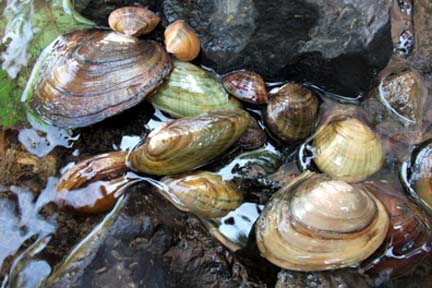
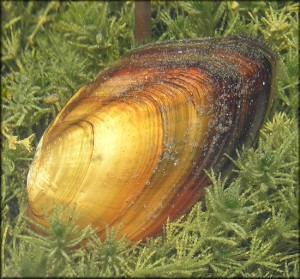
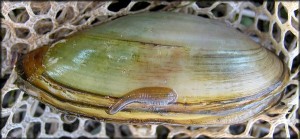
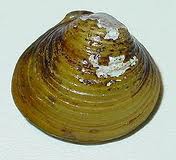
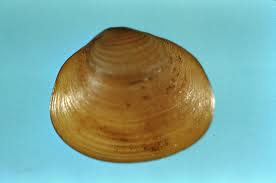
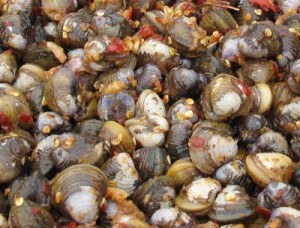
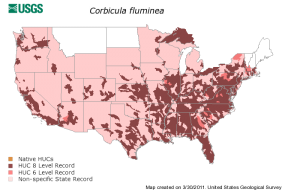
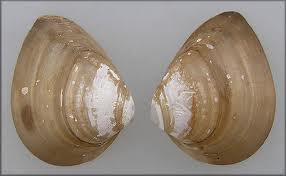
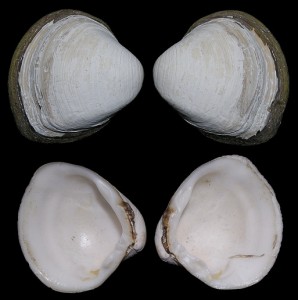
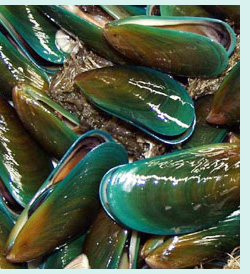
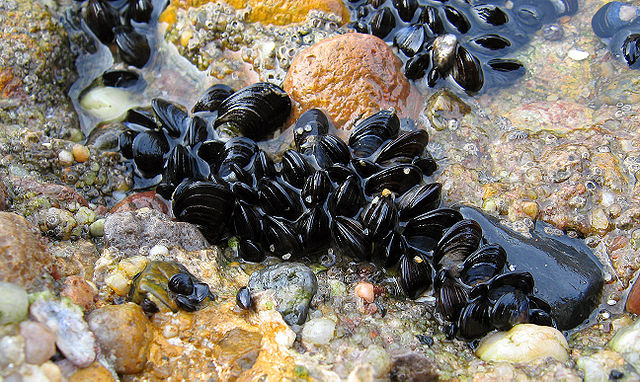

Don’t worry Deane, haha, I plugged your site on the very page that I just posted.
I am a Yarmouth, Maine resident. Do I need a license to mussel in Casco Bay? Is there a ‘mussel map’ to help me find a place to access mussels at low tide? I am not a commercial operation, it’s for family consumption.
Thanks, Jim
Hi… I grew up in Pownal and went to school in Freeport. According to Maine law you can: “…take up to two bushels of shell mussels for personal use without a mussel license.”
Greetings, Just wanted to let people know that as rats, possums, vultures…etc. are scavengers on land the mussels, clams, oysters, shrimp, catfish are the scavengers of the water collecting pollution, chemicals, poisons, diseases in the water.
How many prestine waters do you really know of ?
Though as a former Biology student gone Chef, I have grown up in the area that Green is in. Most of the waters here are okay to take fish from but an abundance of these “Scavengers” or bottom feeders (like coquina muscles) that are alive in the habitat that they actually belong in normally means that the habitat is Thriving. But As Green Dean states many times in his articles and his videos involving aquatic plants and animals, you should check with local environmentalists to be 100% sure.
There is no bag, possession, or size limit on Asian Clams in Florida., so their laws are not “odd”. The 1.5 inches is a typical size, not a minimum size ( shown in the fishing regulations document). See 68A-23.015 FAC.
I think putting a size limit on a clam species you want to get rid of is odd.
My 14 yr old ate a clam raw out of the lake water and I am worried now that he is gonna be sick